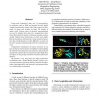Free Online Productivity Tools
i2Speak
i2Symbol
i2OCR
iTex2Img
iWeb2Print
iWeb2Shot
i2Type
iPdf2Split
iPdf2Merge
i2Bopomofo
i2Arabic
i2Style
i2Image
i2PDF
iLatex2Rtf
Sci2ools
BIBE
2004
IEEE
2004
IEEE
Interactive 3D Protein Structure Visualization Using Virtual Reality
Large-scale biomedical data sets of macromolecular structures such as DNA and proteins describe highly complex biomolecular entities which often consist of thousands of atoms and residues in large 3D strands of ids. Various types of abstract representations are used to display these data sets, ranging from traditional ball-and-stick models to feature-presenting cartoon models. Despite these abstractions, even the most simplified representations still generate a large amount of geometry data. Useful features are often difficult to recognize in the sheer amount of detail produced by the rendering software. Comparative visualization of various structures in any abstract representation is helpful for understanding the relation between function and structure, and prediction of properties of newly discovered proteins which might have an impact on drug design and better treatment options for diseases. We present a case study that uses high performance workstations and a Virtual Reality displ...
| Added | 20 Aug 2010 |
| Updated | 20 Aug 2010 |
| Type | Conference |
| Year | 2004 |
| Where | BIBE |
| Authors | Elke Moritz, Jörg Meyer |
Comments (0)

